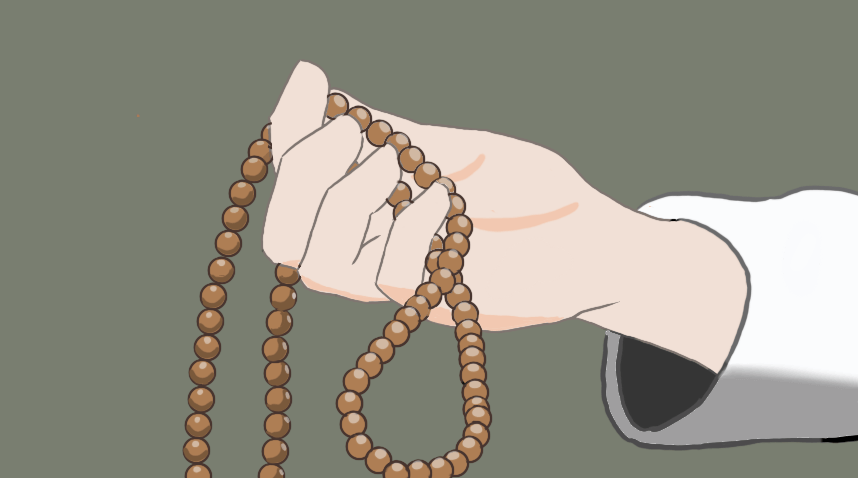TLDR: When getting sufficient sleep, the following 3 practices helped me to almost entirely overcome drowsiness in sitting meditation: (1) keeping my eyes open, (2) using mala beads, and (3) silently or audibly reciting the Buddha’s name, the names of the Triple Gem, or the Buddha’s qualities.
My Past: Frequent Drowsiness Made It Hard To Stick to a Regular Sitting Meditation Routine
After discovering Buddhism during my university days, I was enamoured by the wisdom of the teachings, but one thing frequently hindered my sitting meditation practice.
For many years, my sitting meditation was beset by frequent bouts of overwhelming drowsiness. On many days, unless especially well-rested, I usually fall wholly or partially asleep after a few minutes. Surprisingly, I often felt drowsier during sitting meditation than afterwards when trying to fall asleep.
For many years, this drowsiness hindered my attempts to stick to a sitting meditation routine since I would nod off after a few minutes.
Change 1: Keeping Eyes Open During Sitting Meditation
Zen Buddhism is one of the more widely practised Buddhist traditions in America (where I am from) and one of the first Buddhist traditions I explored. In some Zen traditions, sitting meditation is done with the eyes open.
Learning this, during my sitting meditation, I let my eyes rest on a point on the wall, floor, corner, or dim light source such as a lamp. This helped to reduce some drowsiness, although it wasn’t until combining this technique with the other two techniques below that things significantly improved.
Change 2: Mala beads To Help Focus

Wanting to explore Buddhism more deeply but having limited options where I lived, I resolved to study in India to learn more about the subcontinent where Buddha was born.
After much planning and financial saving, I hopped on a plane and the adventure began. My time in India was extremely insightful and life-changing. Furthermore, while exploring Dharamsala, India, the ubiquitous mala beads for sale there constantly called my attention to them. Having purchased a string of 108 beads, the next phase of my journey to overcoming drowsiness began.
As Master Sheng Yen teaches and I have experienced:
“…the deliberate action of the fingers moving the beads may serve as a quick reminder to focus on the recitation, should the mind stray. The functions of reminding and counting complement each other…”
At that time, I used the mala beads with a Tibetan mantra. As I used the mala beads more and more with the mantra, I found that the mala beads helped my mind to stray less often. I also found that the sensation of mala beads on my fingers was easier to focus on, and more stable than the breath, which was more subtle and harder for me to follow.
Moreover, even if trying to focus on breathing, the beads were still helpful by providing an additional anchor point.
If my attention strayed from the breath, it could drift to the sensation of touching the beads instead of wandering off.
As I continued to practice the mantra with the mala beads, I further discovered that the fingers’ movement also helped keep my mind more active, especially if moving them quickly. Between the improved focus and more active mind, my drowsiness further diminished.
Change 3: Silent or Audible Recitation of The Buddha, The Triple Gem, or His Qualities to Rouse Energy and Grow Faith

In SN46.51, the Buddha provides another helpful piece of advice:
And what is the lack of food for the arising of unarisen sloth & drowsiness, or for the growth & increase of sloth & drowsiness once it has arisen? There is the potential for effort, the potential for exertion, the potential for striving. To foster appropriate attention to them: This is lack of food for the arising of unarisen sloth & drowsiness, or for the growth & increase of sloth & drowsiness once it has arisen.
Although keeping my eyes open and using mala beads with a mantra had been helpful, a piece was missing.
For many years I had difficulty rousing energy reliably, which as mentioned above is important to reduce and prevent drowsiness.
Nevertheless, although dealing with drowsiness, I was still inspired by Buddha’s teachings. While exploring the available Buddhist traditions, I came upon the teachings of the Japanese Buddhist monk Honen Shonin who taught reciting the Buddha’s name while sitting, standing, walking, and lying down.
Being drawn to this practice of mindfulness of the Buddha, I found the Pali Canon frequently extols the many benefits of mindfulness of the Buddha and the Triple Gem as a whole, from being free from fear, purifying the mind of the three poisons, and leading to the arising of joy and rapture.
Regarding modern teachers, I discovered the Thai Forest teacher Ajahn Anan’s teaching about mindfulness of the Buddha:
Knowing that it is hard, we need to firmly set sati to the task of guarding the heart and bringing it to calm. If we are going to practice samādhi in this way, we need to keep “Buddho” constantly with us.
Whether we are standing, sitting, walking, lying down, or whatever else we might be doing, we have to keep the meditation word “Buddho” always in the heart.
These are benefits I began to experience.
As time went by and I learned and experienced more and more joy and the other benefits, my faith in Buddhism began to grow and grow, which consequently fueled the arising of mental energy and exertion during sitting meditation, overpowering the drowsiness.
What Things Are Like Now
Having practised like this, combining all 3 of these changes for over a year, although I sometimes still feel drowsiness, it doesn’t overwhelm me like it did before.
Now that sitting meditation contains so much more alertness, energy, and joy, maintaining a regular sitting meditation routine has become much easier and more enjoyable.
Wise Steps:
If even after adjusting your bedtime routine to ensure sufficient sleep, you are still having problems with drowsiness in sitting meditation, try the following:
- Keep your eyes open and stare at a point on the wall, floor, corner, or dim light source such as a lamp.
- If doing a type of meditation that can be counted, including breath-counting or mindfulness of the Buddha, try using mala beads. See these mala bead usage instructions from Dharma Drum for more information on how to use them.
- Find a meditative practice that rouses energy and joy for you.


